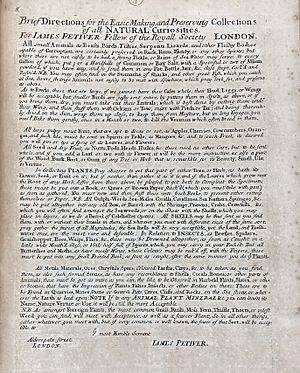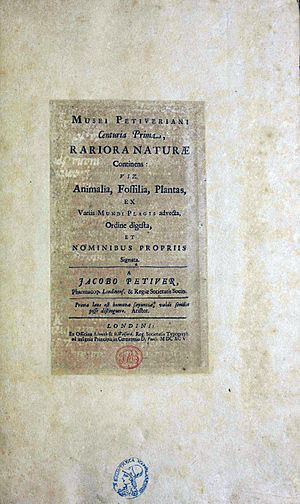James Petiver facts for kids
James Petiver (born around 1665 – died around April 2, 1718) was a London apothecary, which is like a pharmacist who also prepared medicines. He was a member of the Royal Society, a famous group for scientists, and also part of London's informal Temple Coffee House Botany Club. James Petiver was well-known for his huge collections of plant and insect specimens. He studied botany (plants) and entomology (insects). He wrote letters to other famous scientists like John Ray and Maria Sibylla Merian. Some of his notes and specimens were even used by Carolus Linnaeus to describe new species. A plant group called Petiveria was named after him by Charles Plumier. After he died, his collections were bought by Sir Hans Sloane and later became part of the Natural History Museum in London.
Contents
Life of James Petiver
James Petiver was born between 1663 and 1665 in a place called Hillmorton in England. His family moved to London when he was young. His father was a haberdasher, someone who sold small sewing items. After his father passed away in 1676, James went to Rugby Free School.
He later said he wished he could have gone to university. Instead, he became an apprentice to an apothecary named Charles Feltham in London in 1677. An apprentice learns a trade by working for an expert. In 1685, he became a full member of the Society of Apothecaries. He even supplied medicine to St. Bartholomew's Hospital.
Starting His Own Practice
In 1692, James Petiver opened his own apothecary business. It was called "at the sign of the white cross" on Aldersgate in London. He lived there for the rest of his life. He probably became interested in nature by visiting gardens like the one at the Society for Apothecaries.
He was influenced by other early naturalists like John Watts. He also joined the Temple Coffee House Botany Club. This was an informal group that met to talk about plants. Famous people like Dr. Hans Sloane were part of this club.
Building a Global Collection
Petiver started collecting natural history objects. His office became a busy place for travelers and collectors to visit. He had a large network of people who sent him specimens. These collectors included people from far-off places like Virginia, Madras (now Chennai), Africa, Jamaica, and Bermuda.
In 1695, he published a list of his collections. It was called Musei Petiverani Centuria Prima Rariora Naturae Continens. He received many specimens and seeds through the mail. He even sent instructions to his collectors on how to gather things. One visitor noted that Petiver had so many specimens, they were just piled up!
In 1700, he became the Apothecary to the Charterhouse, another important role. James Petiver did not travel much himself. He mostly stayed in London, with a few trips to Bristol, Cambridge, and the Netherlands. He was very good at organizing things. This skill helped him in the Royal Society, where he became a member in 1695.
James Petiver never got married. He was found dead around April 2, 1718, after being sick for a long time. He was buried at St Botolph Church in London. Sir Hans Sloane was one of the people who carried his coffin.
His Scientific Discoveries
James Petiver built the largest collection of natural history specimens of his time. He used a worldwide network of collectors. Many of these collectors worked on trading ships or navy vessels.
In 1711, Petiver visited the Netherlands. He went there for Hans Sloane to study the collections of a Dutch insect expert named Paul Hermann. He also met other Dutch naturalists like Boerhaave. He even received an honorary degree from the University of Leiden.
Studying Butterflies
Petiver was very interested in butterflies. He wrote down many English folk names for them. He also made up some names himself. He wrote some of the first butterfly books that used English names along with Latin ones. Even though he was a respected gentleman, he wasn't very good at Latin.
He gave the name "white admiral" to the white admiral butterfly. He also named a group of butterflies "fritillary" (Argynnini) because their patterns looked like a checkered dice box. He called skippers "hogs" and swallowtails "Royal Williams." He named walls "Enfield Eyes" and marbled whites "Half-Mourners."
His Amazing Collections
Petiver received many specimens, seeds, and other materials from his friends overseas. These included people like Samuel Browne from Madras and Georg Joseph Kamel from Manila. Petiver would trade these specimens, sometimes for a lot of money.
After he died, his collections went to his sister Jane Woodstock. Sir Hans Sloane bought them from her for £4000. Today, parts of his amazing collection are kept at the Natural History Museum in London. When Sloane bought the collections in 1718, he found they needed a lot of organizing.
What He Published
James Petiver wrote several important books and papers about his discoveries:
- 1698 — An account of some Indian plants etc. This was a letter about Indian plants, their names, and uses. It was published in the Philosophical Transactions of the Royal Society.
- 1700–1703 — An account of part of a collection of curious plants and drugs. This paper described plants and drugs given to the Royal Society by the East India Company.
- Gazophylacium naturae et artis (1702–06) — This was a book with pictures of British insects.
- Papilionum Britanniae icones (1717) — This book showed 80 British butterflies. It also included information about their life cycles, based on Petiver raising them himself.



